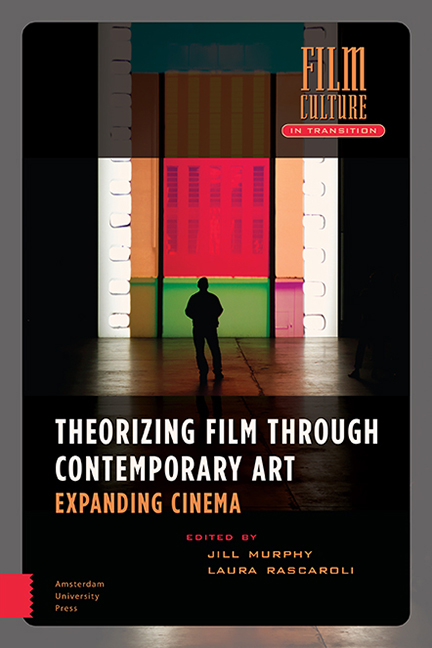Book contents
- Frontmater
- Dedication
- Contents
- List of Illustrations
- Acknowledgments
- Foreword: Courtesy of the Artists
- Introduction: On Cinema Expanding
- Part One Materialities
- 1 Cinema as (In)Visible Object; Looking, Making, and Remaking
- 2 Objects in Time; Artefacts in Artists’ Moving Image
- 3 Materializing the Body of the Actor; Labour, Memory, and Storage
- 4 How to Spell ‘Film’; Gibson + Recoder’s Alphabet of Projection
- Part Two Immaterialities
- 5 The Magic of Shadows; Distancing and Exposure in William Kentridge’s More Sweetly Play the Dance
- 6 Douglas Gordon and the Gallery of the Mind
- 7 A Throw of the Dice Will Never Abolish Chance; Tacita Dean’s Section Cinema (Homage to Marcel Broodthaers)
- Part Three Temporalities
- 8 The Photo-Filmic Diorama
- 9 The Cinematic Dispositif and Its Ghost; Sugimoto’s Theaters
- 10 Time/Frame: On Cinematic Duration
- Part Four The Futures of the Image
- 11 Interactivity without Control; David OReilly’s Everything (2017) and the Representation of Totality
- 12 Post-Cinematic Unframing
- 13 Absolute Immanence
- Index
9 - The Cinematic Dispositif and Its Ghost; Sugimoto’s Theaters
Published online by Cambridge University Press: 23 June 2021
- Frontmater
- Dedication
- Contents
- List of Illustrations
- Acknowledgments
- Foreword: Courtesy of the Artists
- Introduction: On Cinema Expanding
- Part One Materialities
- 1 Cinema as (In)Visible Object; Looking, Making, and Remaking
- 2 Objects in Time; Artefacts in Artists’ Moving Image
- 3 Materializing the Body of the Actor; Labour, Memory, and Storage
- 4 How to Spell ‘Film’; Gibson + Recoder’s Alphabet of Projection
- Part Two Immaterialities
- 5 The Magic of Shadows; Distancing and Exposure in William Kentridge’s More Sweetly Play the Dance
- 6 Douglas Gordon and the Gallery of the Mind
- 7 A Throw of the Dice Will Never Abolish Chance; Tacita Dean’s Section Cinema (Homage to Marcel Broodthaers)
- Part Three Temporalities
- 8 The Photo-Filmic Diorama
- 9 The Cinematic Dispositif and Its Ghost; Sugimoto’s Theaters
- 10 Time/Frame: On Cinematic Duration
- Part Four The Futures of the Image
- 11 Interactivity without Control; David OReilly’s Everything (2017) and the Representation of Totality
- 12 Post-Cinematic Unframing
- 13 Absolute Immanence
- Index
Summary
Abstract
This chapter will engage with the work of the artist and photographer Hiroshi Sugimoto in order to reflect on the nature of the cinematic apparatus in the digital era. Sugimoto's photographic work Theatres consists in a series of photographs of cinema theatres taken by the artist from the 1980s applying a wide-open aperture and an exposure as long as the film itself, capturing de facto an average of 170,000 frames in a single shot. The result is a ‘film in a single frame’, and a profound reflection on the role that time, lights, and the space of the audience play in the cinematic experience. The chapter looks from a cinematic perspective at the regenerative aspect of the photographic medium in its after-shot, a question called by Sugimoto a ‘resurrection’.
Keywords: Dispositif, Agamben, Sugimoto, Sugimoto's Theaters, Ruinophilia
From photography to site-specific art, the work of Hiroshi Sugimoto is characterized by a profound reflection on time and space, in particular with reference to the theatricality of his photographic practice. Looking at his decades-long career, scholars and critics have thoroughly examined his approach to the medium and the peculiarities of the objects portrayed in his work, focussing on the ways in which his black-and-white, long-exposure photography expands our understanding of the photographic apparatus. Sugimoto's work, in fact, arguably presents a series of affinities with, and reflects on, other arts, in particular performance art and the cinema. Giuliana Bruno, for instance, discusses the relationship between Sugimoto's photographic series such as Dioramas and Wax Museums and the origins of cinema. She points out that, from a cinematic perspective, the photographer's portrayals of movie theatres, wax statues, dioramas, and seascapes represent an itinerary through the genealogy of cinematic space, to the extent that Sugimoto's ‘work pictures the hybrid, spatial archaeology of the cinema’. Michael Fried, comparing Sugimoto's work with Cindy Sherman's and Jeff Wall’s, suggests that, with specific reference to the question of theatricality,
one way of understanding Sugimoto's Movie Theaters, Sherman's Untitled Film Stills, and Wall's Movie Audience is as responding in different ways to the problematic status of movies in this regard by making photographs which […] also provide a certain essentially photographic distance from the filmic experience.
- Type
- Chapter
- Information
- Theorizing Film Through Contemporary ArtExpanding Cinema, pp. 195 - 212Publisher: Amsterdam University PressPrint publication year: 2020



